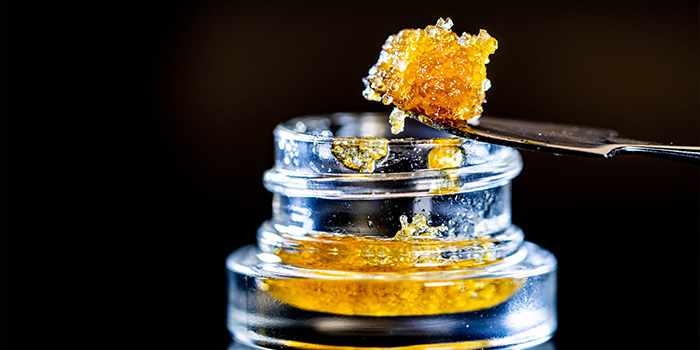
Cannabis plants are covered by microscopic, mushroom-shaped, hair-like compounds called trichomes. These outgrowths surround the budding marijuana flower and produce the plant’s cannabinoids. Different varieties of trichomes can be collected. The resulting products—collectively called cannabis concentrates—can contain very high levels of tetrahydrocannabinol, commonly referred to as THC, the psychotropic ingredient in marijuana. These THC-rich marijuana products may be vaporized and inhaled using a vape pen or through a process called dabbing.
Marijuana concentrates can be made in a commercial environment with modern equipment or prepared in a home setting. They are produced in various ways, including:
- dry processing
- dry ice processing
- water-based processing
- combining pressure with heat
- using nonflammable carbon dioxide solvents
- using flammable solvents, including butane (lighter fluid), propane, ether or alcohol
Using flammable solvents is popular because the products have high THC levels, 1 users report longer-lasting effects,1 and it is a relatively inexpensive and efficient production method. Butane is a commonly used solvent, producing the potent marijuana concentrate butane hash oil (BHO).
The products resulting from these methods may be:
- a gooey liquid wax
- a soft solid with a texture like lip balm
- a hard, amber-colored solid
Hash oil and waxes can be consumed using vape pens. Solids can also be placed on a heated platform usually made of titanium, quartz, or ceramic, where they are vaporized by high heat and inhaled through a dabbing tool, often called a rig
The terms used to describe these products vary. Concentrates is a broad term referring to all products that have been extracted from the plant. Although extracts and concentrates are often used interchangeably, some people define extracts as products manufactured using solvents, but not those pulled from the plant with non-solvent methods. Dabs may refer to products made exclusively from butane hash oil; however, the term is sometimes used colloquially for concentrates extracted in other ways. There are also post-production methods that lead to further variations in products and terms.
There are adverse effects associated with marijuana use in any form, though additional research is needed to understand how the use of concentrate may differ from smoking dried marijuana buds. Marijuana concentrates have very high levels of THC. Solvent-based products tend to be especially potent, with THC levels documented at an average of about 54-69% and reported to exceed 80%, while non-solvent based extraction methods produce average THC levels between 39-60%. In comparison, the THC content in marijuana plant material, which is often used in marijuana cigarettes, is lower—with samples seized by the U.S. Drug Enforcement Agency averaging just over 15%. Not only do concentrates have high levels of THC, but dabbers inhale the entire amount all at once—in a single breath. As a result, concentrates can deliver extremely large amounts of THC to the body quickly. The risks of physical dependence and addiction increase with exposure to high concentrations of THC, and higher doses of THC are more likely to produce anxiety, agitation, paranoia, and psychosis. Additional research is needed to understand how the use of concentrate affects these risks.
In addition, contaminants in concentrate products may be cause for concern. One study noted that 80% of tested concentrate samples were contaminated in some form, not only with pesticides (which is also a concern for dried bud), but also with residual solvents that were not fully purged in the manufacturing process. Users of BHO, for example, likely inhale some butane and other impurities along with the vaporized THC. It is important to note that direct inhalation of concentrated butane among recreational inhalant users carries multiple risks, including reported deaths. However, it is unclear what negative health outcomes result from the inhalation of residual butane, other solvents, or leftover contaminants during the dabbing process.
When solvents are used to produce concentrates, the preparation process itself can be dangerous. A number of people using butane to make extracts at home have caused fires and explosions and have been seriously burned. A study conducted in 2015 looking at implications from marijuana legalization in Colorado reported that in a 2-year period the University of Colorado burn center saw a substantial increase in the number of flash burns that occurred during amateur THC extraction using butane, some involving more than 70% of body surface area and most requiring skin grafting.
It is against federal law to manufacture BHO, and even in some states where adult use of marijuana is legal, like Colorado and California, it is illegal to make hash oil using flammable liquids. In Colorado, state officials recommend alternate methods using nonflammable dry ice (CO2), ice water, or purchasing the product from a licensed marijuana retail store. Most licensed, commercial production facilities use a safer extraction system that prevents solvents from being wasted or exposed to the open air where they could inadvertently be ignited, similar to decades-old systems used in the production of many commercial products.
- Cannabis plants are covered by microscopic, mushroom-shaped, hair-like compounds called trichomes which surround the budding marijuana flower and produce the plant’s cannabinoids.
- Trichomes can be collected and made into concentrates, including extracts and dabs.
- Concentrates can contain very high levels of THC, the psychotropic ingredient in marijuana.
- Concentrates can be made in commercial settings or in a home through several methods, including dry ice- and water-based processing and the use of solvents.
- Using flammable solvents, such as butane, propane, ether or alcohol, is popular because it produces high THC levels, longer-lasting effects, and it’s relatively inexpensive.
- Using butane as a solvent produces the potent marijuana concentrate butane hash oil (BHO).
- Exposure to high levels of THC increases the risks of physical dependence and addiction. Higher doses of THC are more likely to produce anxiety, agitation, paranoia, and psychosis.
- Contamination with pesticides and residual solvents that weren’t fully removed during production is a concern. People who use BHO likely inhale some butane and other impurities along with the vaporized THC.
Concentrates can be vaporized and inhaled using a vape pen or by dabbing.
This publication is available for your use and may be reproduced in its entirety without permission from NIDA. Citation of the source is appreciated, using the following language:
Source: National Institute on Drug Abuse; National Institutes of Health; U.S. Department of Health and Human Services.


